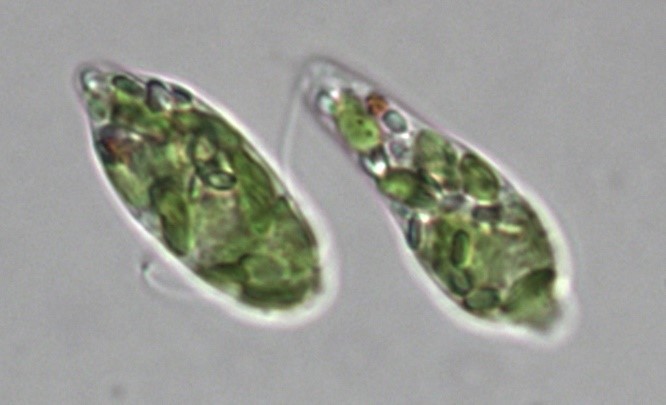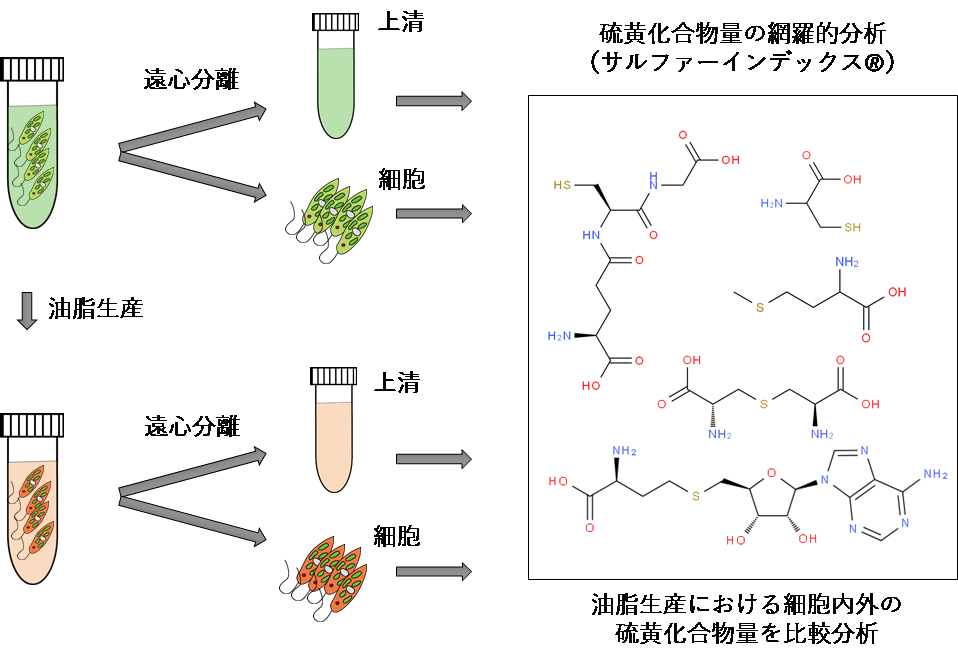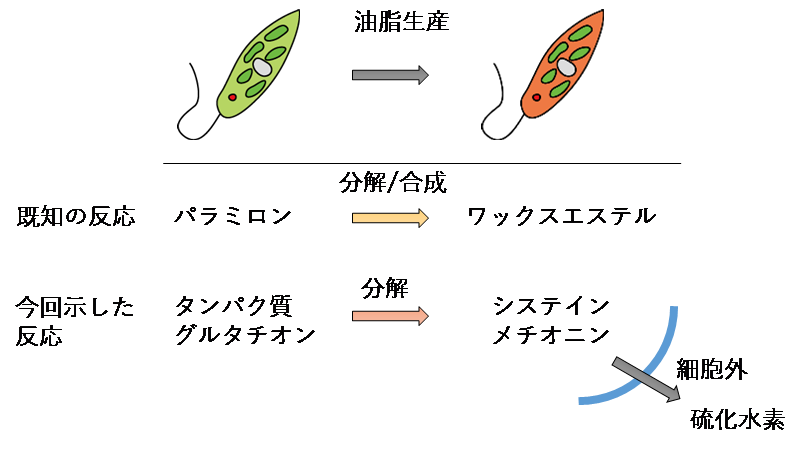Press Releases
* Please note that the news release contains the content at the time of the announcement and may differ from the latest information.
ミドリムシが油を生産する際の硫黄に関する副次的反応を解明
バイオ燃料生産効率化に貢献する成果
Euglena Co., Ltd.
National Research and Development Corporation RIKEN
University of Tsukuba
point
○ The metabolism of sulfur compounds in Euglena was observed using the sulfur index.
○ It was confirmed that hydrogen sulfide was generated when Euglena produced oil, and the cause was clarified.
○ It is expected to contribute to the efficiency improvement of biofuel production using fats and oils produced by Euglena.
| Euglena Co., Ltd., RIKEN, and a research team at the University of Tsukuba have clarified the actual state of metabolic changes in sulfur compounds during the production of fats and oils of Euglena (scientific name: microalgae Euglena). Euglena is being applied to foods and biofuels. In particular, as an issue when applying it to biofuel production, the generation of sulfur compound-based odors in the process of producing fats and oils is raised as an issue at the same time as increasing productivity. This research team uses hydrogen sulfide (* 2) as the main component of the odor generated by utilizing the sulfur index (* 1), which is a technology that can comprehensively analyze sulfur compounds in samples. Furthermore, it was clarified that the cause of its occurrence is the degradation of protein in Euglena cells and glutathione (* 3). Based on this information, it is thought that it will be possible to increase the productivity of Euglena's fats and oils and develop technologies that suppress the generation of odors, and it is expected to be useful in accelerating research on high-efficiency biofuels. .. The results of this research will be published on January 29, 2019 at 10 am (UK time) in the electronic journal "Scientific Reports" of the Nature Publishing Group (NPG) (www.nature.com/articles/s41598-018-36600-z).) Was published. |
This result was obtained through the cooperation of the following teams.
| Euglena Co., Ltd. Executive Officer in charge of Research and Development Director of Advanced Technology Research Department PrincipalInvestigator: Kengo Suzuki (Team Leader) |
RIKEN RIKEN Center for Sustainable Resource Science Bio-Production Information Research Team Team Leader Research Leader: Keiichi Mochida |
University of Tsukuba Associate Professor of Life and Environment Principal Investigator: Takeo Otsu |
 |
 |
 |
Euglena Co., Ltd. and RIKEN is a joint research and development team (microalgae production control technology research) as part of the "Baton Zone Research Promotion Program", a collaborative activity promoted by RIKEN that emphasizes the needs of industry. We are promoting cooperation by establishing a team).
<RIKEN Baton Zone Research Promotion Program>
■ R & D team: Microalgae production control technology research team
■ Research period: April 2018-March 2023
■ Team leader: Kengo Suzuki (Euglena Co., Ltd.)
■ About the program: http://www.riken.jp/research/labs/bzp/
In addition, Euglena Co., Ltd. and the University of Tsukuba have started the "Self-medication Promotion Special Research Project" aiming to build new indicators and diagnostic methods for diseases using sulfur compounds, and have developed advanced analysis methods for sulfur compounds. We are promoting the practical application to self-medication related businesses based on.
<Self-medication promotion special research project>
■ R & D system: Euglena Co., Ltd., University of Tsukuba
■ Research period: July 2018-March 2021
■ About business: https://www.tsukuba.ac.jp/wp-content/uploads/108629euglena.pdf
<Announcement content>
1) Background and background of the research
Euglena (Euglena) is a type of microalgae and is a unicellular organism that is familiar to observations in science experiments that inhabit freshwater lakes and rice fields. Of the more than 50 known species of Euglena, Euglena (Euglena gracilis, Fig. 1) has been used as a model organism (* 4) for more than 50 years, but its abundant nutrients and Due to the functionality of paramylon (* 5), which is a β-glucan that accumulates in cells, industrial use is also being considered, and with the establishment of mass production technology in 2005, it will be supplied as a raw material for health foods by Euglena Co., Ltd.・ It has been used.
Euglena is known to contain abundant nutrients and at the same time accumulate a high proportion of fats and oils under specific conditions, and its mechanism has also been the subject of research. Based on the results of these studies, paramylon accumulated in cells is decomposed to obtain energy in the absence of oxygen in the surroundings, and unnecessary substances in the reaction are accumulated in the form of oils and fats called wax esters (* 6). It is clear that This phenomenon is called wax ester fermentation (* 7) as a fermentation peculiar to Euglena. Since Euglena wax ester is considered to be suitable as a raw material for biofuels, its use in biofuel production is being considered and technological development is progressing.
The previously known reaction of extracting energy from paramylon and accumulating unnecessary substances as fats and oils has been an intracellular reaction flow focusing on carbon. On the other hand, it has been empirically known that the odor of sulfur compounds is generated from Euglena when fats and oils accumulate, but the phenomenon has not been investigated deeply. In this study, we are trying to clarify the mechanism of this odor generation by using the sulfur index. By doing so, we aim to learn more about wax ester fermentation and lead to technological development that increases biofuel productivity.
2) Contents of research
A research team consisting of Euglena Co., Ltd., RIKEN, and the University of Tsukuba processes Euglena to make fats and oils, and analyzes the sample with a sulfur index to occur behind the wax ester fermentation. We have clarified the side reaction related to the sulfur compound.
Sulfur index is a technology that can comprehensively quantify the amount of each sulfur compound by performing metabolome analysis (* 8) on the sulfur compounds in the sample. After the treatment to make fats and oils, Euglena and the culture broth supernatant are collected separately and the sulfur compounds contained in each are measured (Fig. 2). As a result, it was confirmed that hydrogen sulfide was contained in the culture solution supernatant of Euglena that had been made to make fats and oils, and it was found that this was the cause of the odor generation in the wax ester fermentation. Furthermore, by investigating changes in the amount of sulfur compounds contained in the cells, it became clear that the intracellular sulfur-containing amino acids (* 9) such as cysteine and methionine increased in response to the production of fats and oils, and at the same time. It was found that sulfur-containing compounds such as glutathione and protein were reduced. From these facts, changes occur in cells that glutathione and proteins are decomposed and sulfur-containing amino acids such as cysteine and methionine increase, and hydrogen sulfide is generated when these sulfur-containing amino acids are decomposed for energy acquisition. A new mechanism was suggested (Fig. 3).
Furthermore, we analyzed the molecular causes that promote the decomposition of glutathione during the production of fats and oils by Euglena by bioinformatics. As a result, the amount of γ-glutamyl transpeptidase, an enzyme that contributes to the decomposition of glutathione, does not change, whereas the amount of enzymes corresponding to glutathione-degrading enzymes Dug1p, Dug2p, and Dug3p found in yeast and the like is the same. It became clear that it was increasing. This suggests that the decomposition of glutathione is promoted by strengthening the decomposition pathway consisting of Dug1p, Dug2p, and Dug3p when Euglena produces fats and oils, and a part of the molecular cause of hydrogen sulfide generation has been clarified. ..
3) Future development
This time, we have clarified the side reactions related to sulfur compounds that occur with the wax ester fermentation of Euglena. By knowing this, it is possible to develop a technology to suppress the generation of odor in fat and oil production, prevent the release of odor to the environment when producing biofuel on a large scale, and increase the protein contained in the residue. It helps to increase the utility value for feed. Furthermore, it will be possible to consider measures to increase the productivity of fats and oils in wax ester fermentation, which is expected to help accelerate research on high-efficiency biofuels.
The research in this presentation Euglena Co., Ltd., RIKEN, and the University of Tsukuba. Euglena Co., Ltd. at the University of Tsukuba clarified the overall picture of the phenomenon, and bioinformatics at the RIKEN Center for Sustainable Resource Science suggests further involvement in the phenomenon. Presented the enzyme to be.
Euglena Co., Ltd. and the University of Tsukuba, we are planning and executing various researches including the research in this presentation for the purpose of promoting the utilization of the sulfur index. In addition, we are accelerating collaboration between Euglena Co., Ltd. and RIKEN by establishing a joint team in the "Baton Zone Research Promotion Program" at RIKEN.
<Reference diagram>

Figure 1. Photograph of Euglena

Figure 2. Outline of sample preparation and comparative analysis for comprehensive investigation of sulfur compounds
 Figure 3. Phenomena discovered in this study
Figure 3. Phenomena discovered in this study
Discovery of previously overlooked side reactions in fat production
<Glossary>
* 1 Sulfur index
A service that comprehensively analyzes the amount of sulfur compounds in a sample based on LC-MS / MS analysis. http://www.euglena.jp/sulfurindex/
(Takeo Otsu and Satoshi Oshiro "Method for quantifying volatile small molecule sulfur compounds and evaluation method for sulfur compound-containing substances" Japanese Patent No. 6426329 / WO / 2018/201879 /
PCT / JP2018 / 018154 / Special application 2017-094037)
* 2 Hydrogen sulfide
It is a compound consisting of sulfur and hydrogen, and its chemical formula is H 2 S. It is known as a cause of rotten egg odor in sulfur hot springs.
* 3 Glutathione
A compound in which glutamic acid is bound to a dipeptide consisting of cysteine and glycine via a carboxyl group in the side chain. It is present in a relatively high concentration inside the cell and
It takes various states, mainly the reduced type and the oxidized type. The reduced form exhibits an antioxidant effect by being oxidized.
* 4 Model organisms
An easy-to-handle organism that is used as an object when studying life phenomena common to living organisms.
* 5 Paramylon
Crystalline β-1,3-glucan granules in which only Euglena and its near-green species accumulate as stored polysaccharides. It has been reported to exhibit various food functionality.
* 6 Wax ester
A compound produced by an ester bond between a long-chain fatty acid and an aliphatic alcohol. The wax ester produced by Euglena has a carbon chain of fatty acid and alcohol, respectively.
It is characteristic that the length is about 14 in the center.
* 7 Wax ester fermentation
When Euglena is exposed to anoxia, it metabolizes sugars in an oxygen-independent manner to gain energy and stores by-products in the form of wax esters.
reaction. It was named wax ester fermentation because it produces wax esters through an anaerobic reaction.
* 8 Metabolome analysis
A method that comprehensively quantifies metabolites possessed by living organisms by using LC-MS, etc., and analyzes changes due to the state of metabolic pathways.
* 9 Sulfur-containing amino acids
Of the amino acids, those that have sulfur in the molecule. Amino acids that make up proteins include cysteine and methionine.
<Announcement magazine>
■ Magazine name: Scientific Reports http://www.nature.com/articles/s41598-018-36600-z
■ Title of the paper: characterization of sulfur-compound metabolism underlying wax-ester fermentation in Euglena gracilis
(Elucidation of the characteristics of sulfur compound metabolism in wax ester fermentation of Euglena)
■ Authors: Koji Yamada, Tomoaki Nitta, Kohei Atsuji, Maeka Shiroyama, Komaki Inoue, Chieko Higuchi, Nobuko Nitta, Satoshi Oshiro, Keiichi Mochida, Osamu Iwata, Iwao Ohtsu, and Kengo Suzuki
-Contact for inquiries from the press-
Euglena Co., Ltd. Corporate Communication Division
